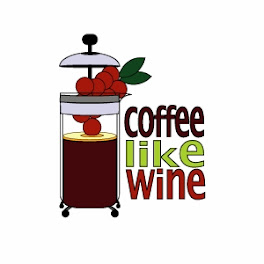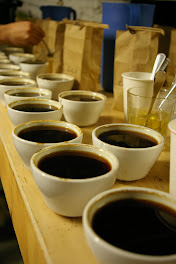
There was an article in the Wall Street Journal last week about the growing interest in making latte art at home. Basically latte art is making designs in your cappuccino by pouring the foam/milk in a particular way. You'll find a little leaf-pattern or heart shape in your cup at most good cafes. Latte art doesn't indicate anything about the quality of coffee beans used to make the drink, but it's a little flourish baristas use to show off their talent with the milk. I've been working on my latte art skills for at least a year now, even going so far as to replace the stock steam wand on my espresso machine from a bulky plastic extension piece to an all-metal, smaller nozzle wand that comes on the more expensive Rancilio Silvia espresso machine. (The wand from Ms. Silvia, as the coffee geek community calls her, is better at producing micro-foam, or foam with tiny air bubbles, versus a messy froth, that's required to pour good latte art).
As the WSJ article indicates, it's a frustrating process, with results maddeningly inconsistent, despite what seems to be the exact same process time and time again. The picture above is my latte art creation from the weekend. It's not pretty, but it's better than most of the amoeba-like blobs I get on a regular basis. My best results come when I use whole milk (Clover brand has worked the best for me lately) and get the tip of the wand just under the surface at an angle, so the steam forces the milk to swirl around the pitcher. As the foam starts to build, I slowly tilt the pitcher at a greater angle to keep the steam blowing right below the surface of the milk.
After attempting to get micofoam, you should bang the pitcher on the table a few times to burst any large air bubbles. Swirl the pitcher as well, since this will integrate the microfoam and milk and make it easier to pour a steady stream into the espresso.
Pouring the actual art is a whole separate act that's as difficult as getting microfoam. From my intense study of baristas in area cafes and checking out demonstrations on youtube, I've learned it helps to have the cup's edge closest to your body tilted down slightly, and pour the milk/foam at that bottom side. After pouring the milk in, you'll notice a little plume created. This indicates it's time to start rocking your hand back and forth to make the pattern. As you do this, the pattern you create moves across the cup away from you, so keep this in mind when you pour. It's why I start at the edge closer to me, instead of the middle of the cup, because it gives me more room to mess around.
I'm still working on getting the pour right, and since I only make one cappuccino a day in the morning (when I'm tired and my hands are as steady as they would be after drinking the cappuccino) my results have been less than stellar.
Anyway, if you have any tips you've learned in your pursuit of latte art, or would like to share something you've made, feel free to post a picture in the comments.









4 comments:
Ciao,
That was me in the video, struggling to get a decent pour. Cari, the WSJ's reporter in SF, found me at CoffeeGeek.com's forum. Her article appeared in the Aug. 14 print edition as well, on the front page.
Ironically, after my vacation in Kauai (after Cari's deadline), I nailed a rosetta on the first try! I just had to laugh. Sometimes "trying harder" doesn't work. And this is, you gotta admit, one of the most trivial pursuits humans ever invented. :)
Happy Frothing,
Wayne
if you want to develop your foam skills, i recommend quitting the day job and taking a post at any espresso joint. you'll have the foam perfect in a week.
Yeah, I'd love to work at a cafe for a bit just to improve my skills - they make more espresso drinks in a week than I do all year. But, unfortunately, I have a family to feed, so quitting my day job isn't realistic.
I, too, would not trade my present job to become a barista. Most of them earn less than I do, and at my age, I really have to take that into account.
In any case, I prefer to focus my attention on the espresso side of the equation. Getting the best shots out of Rocky & Sirena is still an ongoing process. I said as much during my interview, but most of that was edited out.
Ciao,
Wayne
Post a Comment